When Bhutan is mentioned, the immediate imagery that often floods one’s mind consists of majestic monasteries perched on cliff edges, tranquil vistas that seem untouched by time, and, of course, the symbolic wonder of the Tiger’s Nest Monastery.
However, beyond these visual treasures lies another element deeply woven into the tapestry of this Himalayan paradise: its rich linguistic heritage. So, a question arises – is there such a thing as the Bhutanese language? While a brief answer would be ‘yes,’ the story behind it is intricate and deserves deeper exploration.
Table of Contents
- Is Butanese A Language? Diving Deep Into The Official Language Of Bhutan
- 15 Things You Should Know About The Bhutanese Language
- 12 Facts About Bhutan: A Mysterious Country In The Himalayan Mountains
- Related Questions
Is Butanese A Language? Diving Deep Into The Official Language Of Bhutan
When one thinks of Bhutan, images of towering monasteries, serene landscapes, and perhaps the iconic Tiger’s Nest Monastery come to mind. But there’s another fascinating facet of this Himalayan kingdom: its language. So, is Bhutanese a language? The simple answer is yes, but let’s delve deeper.
Dzongkha: The Heartbeat Of Bhutan
The national language of Bhutan is Dzongkha, often referred to as Bhutanese. A member of the Tibetan language family, Dzongkha is one of 53 such languages, linking Bhutan to the broader Tibetan cultural world.
The Script: Chhokey – The Dharma Language
Bhutanese people write Dzongkha using the Chhokey script. “Chhokey” literally translates to “Dharma language,” reinforcing the deep spiritual roots of the Bhutanese culture. This script is identical to classical Tibetan, underscoring the historical and cultural connections between Bhutan and its larger neighbor.
Education In Bhutan: English And Dzongkha Go Hand In Hand
In Bhutanese schools, while English is the primary medium of instruction, students also study Dzongkha diligently, ensuring they are well-versed in their national language. This bilingual approach prepares Bhutanese citizens for both local and global interactions.

15 Things You Should Know About The Bhutanese Language
- Historical Roots: The origins of Dzongkha can be traced back to the Tibetan regions, establishing ancient linguistic ties between Bhutan and Tibet.
- Regions Of Dominance: Dzongkha is primarily spoken in the western parts of Bhutan, with other regional languages prevalent in other parts of the country.
- Name Significance: ‘Dzong’ in Dzongkha means ‘fortress.’ Given that many government activities happened in dzongs (fortresses), the language gets its name, suggesting the “language spoken in the dzongs.”
- Similar Languages: Dzongkha shares similarities with the Sikkimese language spoken in the Indian state of Sikkim.
- Script Insights: The Dzongkha script is syllabic, derived from the Tibetan script, and is written from left to right.
- A Growing Vocabulary: Modernization and technological advancements are leading to adding new words to the Dzongkha lexicon.
- Variations: The spoken and written forms of Dzongkha have noticeable differences, much like many other languages worldwide.
- Dzongkha Development Commission: This body is responsible for developing and preserving Dzongkha, ensuring it evolves while maintaining its essence.
- Linguistic Diversity: While Dzongkha is the national language, Bhutan is home to over 19 other languages, reflecting its rich linguistic tapestry.
- Influence Of Buddhism: Many Dzongkha terms and phrases are influenced by Buddhism, reflecting the nation’s spiritual foundation.
- Learning Resources: With increased global interest, resources for learning Dzongkha, including online courses and apps, have emerged.
- Radio And Television: Bhutan Broadcasting Service (BBS) broadcasts programs in Dzongkha, helping promote and preserve the language.
- Festivals And Songs: Traditional Bhutanese songs and festivals often use Dzongkha, showcasing the language’s beauty and depth.
- Poetry And Literature: Dzongkha has a rich tradition of poetry and literature, reflecting Bhutan’s history, values, and way of life.
- Digital Footprint: Efforts are on to make Dzongkha more accessible on digital platforms, including creating compatible fonts and keyboard layouts.
The language of a nation is the mirror of its soul. Bhutan’s heart beats in Dzongkha, an age-old language that tells tales of its past, narrates its present, and whispers hope for its future. As the world becomes more globalized, the importance of preserving and understanding such linguistic treasures only grows, ensuring that the voice of Bhutan continues to resonate through the Himalayas and beyond.
12 Facts About Bhutan: A Mysterious Country In The Himalayan Mountains
Bhutan is indeed a nation shrouded in mystery and tradition. Here are 12 facts that shine a light on this Himalayan gem:

- Happiness Over GDP: Bhutan is the only country globally prioritizing Gross National Happiness (GNH) over Gross Domestic Product (GDP). The concept of GNH is deeply embedded in the nation’s philosophy and policy-making.
- Carbon Negative: Bhutan is the world’s only carbon-negative country, absorbing more carbon dioxide than it produces.
- No Traffic Lights: Thimphu, the capital of Bhutan, is perhaps the only world capital without traffic lights. Instead, police officers in booths manage the traffic with hand movements.
- Unique Dress Code: Bhutan has a national dress code. Men wear a knee-length robe called ‘gho,’ while women wear an ankle-length dress known as ‘kira.’
- Tiger’s Nest Monastery: The Paro Taktsang, or Tiger’s Nest Monastery, is one of the most iconic landmarks in Bhutan. Perched on a cliffside, it’s believed that Guru Rinpoche (Padmasambhava) flew to this location on the back of a tigress to meditate.
- Television And Internet: Bhutan was one of the last countries to introduce television and the Internet to its people, only in 1999.
- Stamp Collectors’ Paradise: Bhutan is known for its innovative and unique stamps, making it a popular destination for philatelists.
- National Sport: Archery is Bhutan’s national sport, and competitions are colorful events accompanied by traditional dances and celebrations.
- Protected Biodiversity: Over 70% of Bhutan is forested, and the constitution mandates that at least 60% of its land remains forested for future generations. This commitment protects a diverse range of flora and fauna.
- Sacred Peaks: There are mountains in Bhutan that remain unclimbed because of the belief that deities reside there. Climbing mountains higher than 6,000 meters has been prohibited since 2003 out of respect for local spiritual beliefs.
- Unique Calendar: Bhutan follows the Buddhist lunar calendar. This means festivals (or ‘tsechus’) don’t have fixed dates on the Gregorian calendar and are a significant tourist attraction, marked by mask dances and traditional rituals.
- Fertility Temple: The Chimi Lhakhang, or ‘Fertility Temple,’ is dedicated to the Divine Madman, Lama Drukpa Kunley. Couples from across the nation and sometimes from other countries visit to pray for children, often receiving a symbolic tap from a wooden phallus.
Each of these facts adds to the allure of Bhutan, painting a picture of a nation that beautifully marries tradition with modernity while remaining rooted in its spiritual and cultural identity.
At A Bus On A Dusty Road, we talk about travel, life, and ex-pat living. We are all about “Living Life As A Global Citizen.” We explore social, cultural, and economic issues and travel.
We would love to have you be part of our community. Sign up for our newsletter to keep up-to-date by clicking here. If you have any questions, you can contact me, Anita, by clicking here.
Listen to our Podcast called Dusty Roads. You can find it on all major podcast platforms. Try out listening to one of our podcasts by clicking here.
Subscribe to our A Bus On A Dusty Road YouTube Channel with great videos and information by clicking here.
Related Questions
Is Yogi Bear’s Jellystone Park Based On Yellowstone Park?
Yogi Bear’s Jellystone is known to be based in Yellowstone National Park, even though it is supposed to represent all U.S. National Parks. Yogi Bear is a fictional cartoon character that has been around since 1958 but has recently seen some reemergence with a new Yogi Bear Movie (2010) and Jellystone Cartoon series (2021).
You can read our blog on Is Yogi Bear’s Jellystone Park Based On Yellowstone Park? by clicking here to learn more.
Why Do Some People Call Themselves Ex-pats And Not Immigrants?
An ex-pat is an individual who goes overseas to work in a foreign country for a specific period. An ex-pat will remain a citizen of their home country; they do not intend to become citizens of the country where they live. On the other hand, an immigrant goes to another country to live permanently and does not return to their home country.
You can discover more by reading our blog, Why Do Some People Call Themselves Ex-pats And Not Immigrants? by clicking here.
Why Is Family History Important? 11 Reasons Why
Family history is important because it can help us connect to our living and dead family. It gives us a core identity of who we are. Family histories can teach us about perseverance, forgiveness, love, heartache, compassion, and sacrifice. Our family histories also teach us about humanity and help us discover faith and God.
By clicking here, you can discover more by reading our blog, Why Is Family History Important? 11 Reasons Why.


